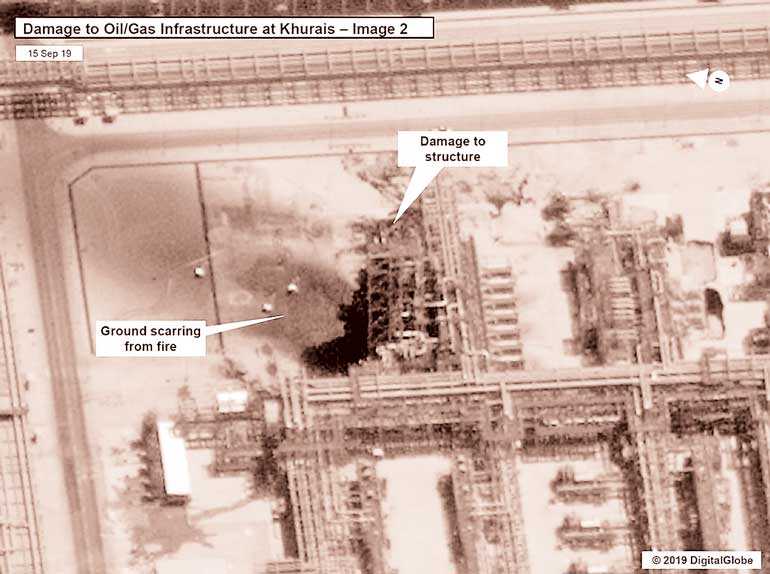Thursday Dec 18, 2025
Thursday Dec 18, 2025
Tuesday, 17 September 2019 00:00 - - {{hitsCtrl.values.hits}}

A satellite image showing damage to oil/gas Saudi Aramco infrastructure at Khurais, in Saudi Arabia in this handout picture released by the U.S Government - Reuters
DUBAI (Reuters) - An attack on Saudi Arabia that shut 5% of global crude output triggered the biggest surge in oil prices since 1991, after U.S. officials blamed Iran and President Donald Trump said Washington was “locked and loaded” to retaliate.
The Iran-aligned Houthi movement that controls Yemen’s capital claimed responsibility for the attack, which damaged the world’s biggest crude oil processing plant. Iran denied blame and said it was ready for “full-fledged war”.
Two sources briefed on state oil company Saudi Aramco’s operations told Reuters it might take months for Saudi oil production to return to normal. Earlier estimates had suggested it could take weeks.
Oil prices surged by as much as 19% before coming off peaks. The intraday jump was the biggest since the 1991 Gulf War.
Prices eased after Trump announced that he would release U.S. emergency supplies and producers said there were enough stocks stored up worldwide to make up for the shortfall. But traders still spoke of a long-term price increase as markets absorb the proof that global supply can be so sharply hit.
“There is reason to believe that we know the culprit, are locked and loaded depending on verification, but are waiting to hear from the Kingdom as to who they believe was the cause of this attack, and under what terms we would proceed!” Trump said on Twitter on Sunday.
U.S. Energy Secretary Rick Perry pinned the blame squarely on Iran for “an attack on the global economy and the global energy market”. “The United States wholeheartedly condemns Iran’s attack on Saudi Arabia and we call on other nations to do the same,” he said in a speech to an annual meeting in Vienna of the U.N. nuclear watchdog IAEA. He added that he was confident the oil market “is resilient and will respond positively”.
While Iran has denied blame for the attacks, its Yemeni allies have promised more strikes to come. Houthi military spokesman Yahya Sarea said the group carried out Saturday’s pre-dawn attack with drones, including some powered by jet engines.
“We assure the Saudi regime that our long arm can reach any place we choose and at the time of our choosing,” Sarea tweeted. “We warn companies and foreigners against being near the plants that we struck because they are still in our sights and could be hit at any moment.”
U.S. officials say they believe that the attacks came from the opposite direction, possibly from Iran itself rather than Yemen, and may have involved cruise missiles. Wherever the attacks were launched, however, they believe Iran is to blame.
“There’s no doubt that Iran is responsible for this. No matter how you slice it, there’s no escaping it. There’s no other candidate,” a U.S. official said on Sunday.
Saudi Arabia and Iran have been enemies for decades and are fighting a number of proxy wars, including in Yemen where Saudi forces have been fighting against the Houthis for four years.
Tension in the oil-producing Gulf region has dramatically escalated this year after Trump imposed severe U.S. sanctions on Iran aimed at halting its oil exports altogether.